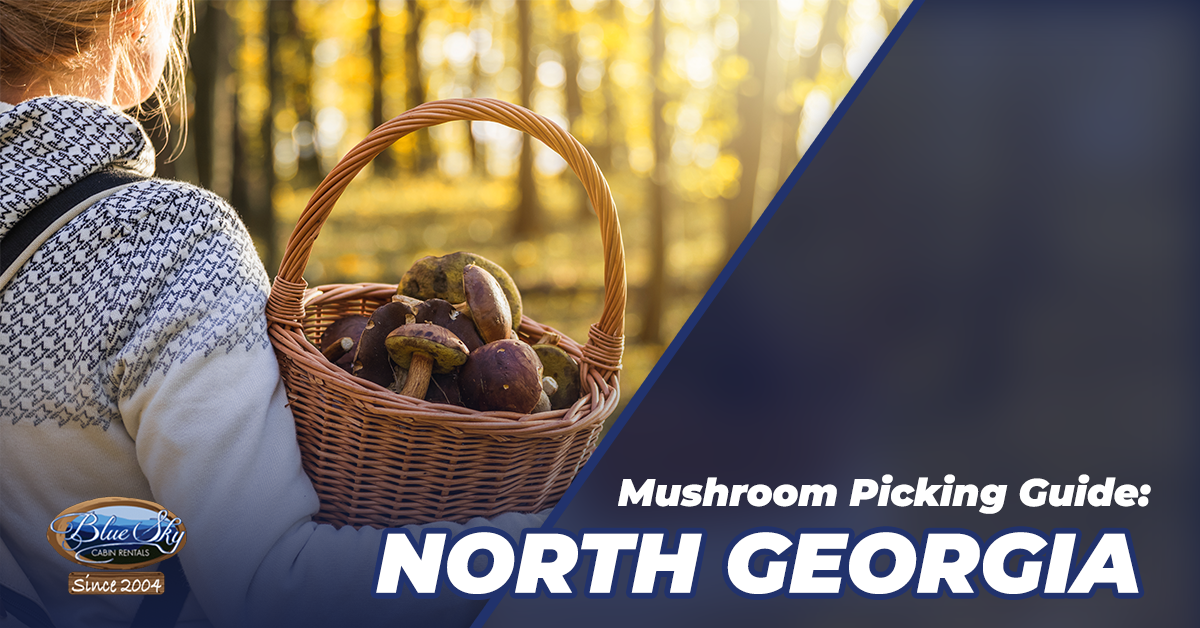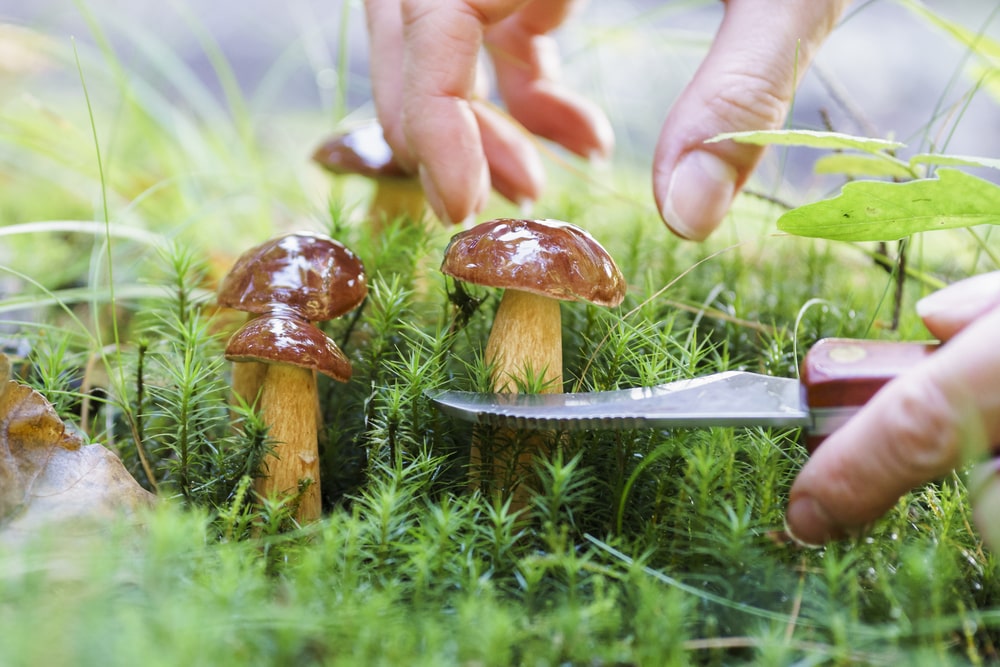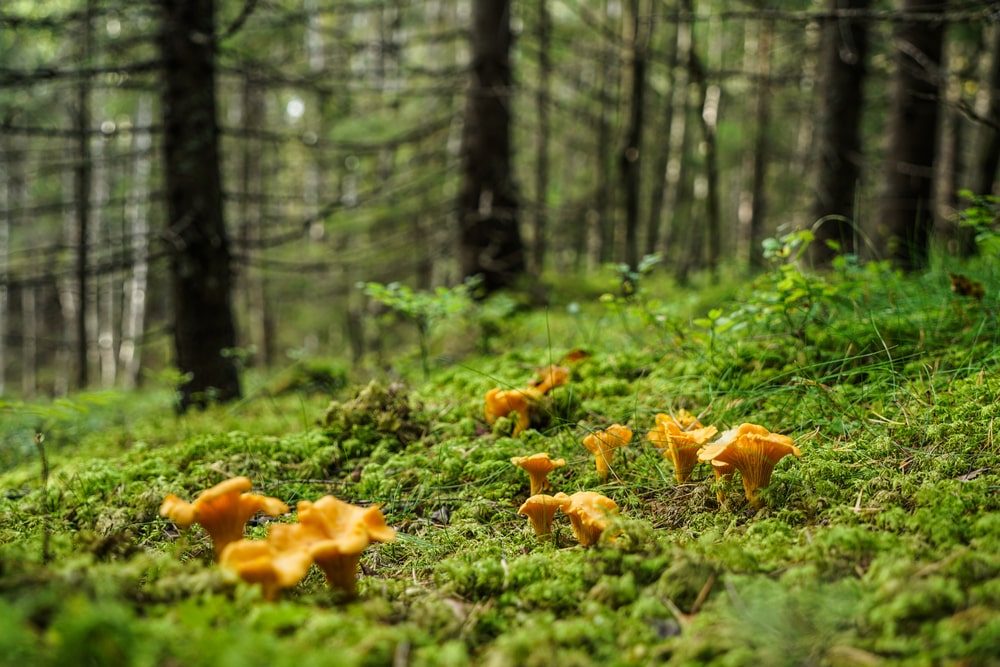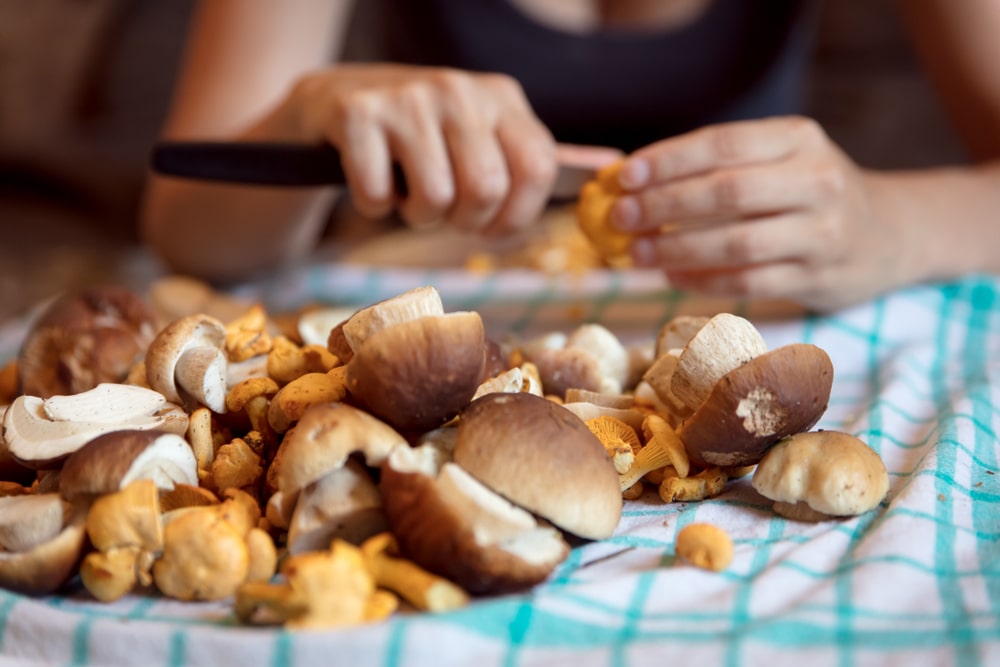North Georgia Mushroom Picking Guide

Summertime in the Blue Ridge & North Georgia Mountains means time spent soaking up the sun at local lakes, hiking through the woods to find hidden swimming holes and natural waterslides, kayaking and tubing down rushing rivers, and bringing home fresh mountain trout for dinner.
As early summer gives way to late summer and fall, however, another popular activity brings enthusiasts flocking to the mountains: mushroom foraging. The Blue Ridge Mountains are a highly sought-after destination for hunting and picking indigenous mushrooms, and we’ve got the inside scoop on where you can find the tastiest edible mushrooms in town. Our Blue Sky Cabin Rentals are a great landing spot for your foraging adventures.
Use our tips below to learn about identifying mushrooms in Georgia and have a safe and successful foraging trip!
Mushroom Picking Equipment

Photo Credit: Alexander Geiger
You won’t need much to embark on your mushroom picking adventure. First and foremost, be sure that you have a credible and up-to-date mushroom identification guide handy.
There are hundreds of types of wild mushrooms, and very few are safe to eat; many are actually poisonous, so proper identification and handling are crucial for safety.
Here are a few mushroom identification apps you can download for convenience, or you can reference a mushroom guide like the one from the National Audubon Society.
You’ll also need a basket or bag to collect the mushrooms, a magnifying glass to help you identify the mushrooms, and a pocket knife or similar tool to extract the mushrooms from the ground.
Other supplies to consider include water and snacks for the hike, proper hiking attire tailored to the weather, sunscreen, bug spray, sunglasses, a notepad and pen for note-taking, and a backpack to carry all these items.
Where to Find Wild Mushrooms in Georgia
As noted above, Fall is the best time of year to find wild mushrooms in Northern Georgia. As a fungus, mushrooms enjoy dark, damp habitats, so heavily forested mountain trails are a goldmine for these tasty treats.
Begin your search near shaded, mossy areas and check around logs, trees, and wood trunks. There are some varieties that grow in fields or drier areas, but the former is a great starting point for finding edible wild mushrooms in Georgia. The Blue Ridge Mountains in Northern Georgia offer plenty of ground to cover during your foray!
Edible Mushrooms in North Georgia
Though the North Georgia and Blue Ridge Mountain region is home to many mushrooms, only a select few are safe for human consumption. It takes a skilled eye and an experienced hunter to find the hidden gems among the forest floor, but the reward is well worth the effort. Here are a few of our favorite local wild mushrooms found in nature.
Bay Bolete
The Bay Bolete mushroom sports a fairly traditional mushroom appearance and is easily confused with other species, so take care to properly identify this delicious delicacy. The stem of the Bay Bolete is often a pale brown or yellow color and can be quite thick.
The bulbous caps are dark rusty brown in color, while the flesh is an off-white hue. Bay Boletes are great roasting mushrooms as a side or addition to classic dishes, or they can be dried and enjoyed as a snack for later.
Chanterelle

Photo Credit: A.Film
Also known as ‘Golden Chanterelles’, chanterelle mushrooms flaunt a bright yellow color and a sweet, apricot-like scent. The caps of these colorful mushrooms are trumpet-shaped, and the edges curl underneath for an irregular shape, which makes chanterelles fairly easy to identify.
These culinary delights provide a delicate flavor, often described as ‘mildly peppery’. Chanterelle mushrooms are great when sautéed in butter as a standalone side dish, or as an accompaniment in soups and stews, a topping for steaks and wild game, or in pasta sauce.
Porcini
-min.jpg)
Photo Credit: Valentyn Volkov
Known for their rich, early flavor and their many health benefits, porcini mushrooms are one of the most sought-after wild mushrooms. This specific species has a symbiotic relationship with trees and can easily be found wrapped around roots and trunks. Porcini mushrooms have a thick stalk, usually between three and five inches tall, and a dark brown cap.
Fresh porcini mushrooms are a great stand-alone side after a nice roast or a great addition to pasta, risotto, casseroles, and more. They are also great in any recipe that traditionally calls for cremini or portobello mushrooms.
How to Identify Wild Mushrooms
Proper mushroom identification is key to a safe hunting experience! With several hundred mushroom species available in the wild, it can be overwhelming at first to recognize the subtle nuances that separate a ‘safe’ mushroom from a ‘not safe’ mushroom—but we’re here to help.
To begin, familiarize yourself with the four main body parts of a mushroom:
- Cap - the umbrella-shaped ‘hat’ that sits on top of the mushroom stalk
- Gills, tubes, spines, and ridges - this feature sits on the bottom side of the cap and looks a little different on each mushroom
- Stalk - the stalk holds the mushroom cap
- Mycelium - the root of the plant that pushes the mushroom forward for spore dispersal and foraging
It can be incredibly helpful to have an app or a foraging book handy during your hunt. These handy tools will outline everything you need to know about edible wild mushrooms and give you information on the typical size, color, and distinctive features of each mushroom.
Pro tip: Wild mushrooms are different than common lawn mushrooms, which are typically an indication that there is a lot of organic matter in your soil and grass. Lawn mushrooms are typically not edible. Just because it looks familiar or has a common name, doesn't mean it's tasty!
How to Pick Wild Mushrooms
Properly identifying a wild mushroom is the hard part—the rest is fairly easy.
First, make sure you only pick fully grown mushrooms that have a well-developed cap, versus the less developed ‘button’ stage. From there, you can either cut the mushroom where it meets the ground or extract the entire mushroom body from the ground; there are various theories on which method is actually better, so we encourage you to research further if you’re curious or passionate about mushroom picking. But, for beginners and hobbyists, either method will yield the same result—a tasty fresh mushroom.
You should avoid picking a mushroom if you have any doubts about its classification, if it is not fully developed with a healthy cap, if you notice any portion has been nibbled on or detached, or if the mushroom smells abnormal.
Like most hobbies, practice makes perfect! The more you forage and find mushrooms, the better you’ll become at developing a keen sense for the individual mushroom characteristics.
Mushroom Picking Safety and Tips
Never taste a mushroom (or anything else you find in the wild) without properly identifying it first! If possible, bring along an experienced mushroom picker for additional help. After you are certain that the mushrooms are safe for human consumption, plan to eat them the same day they are picked for maximum freshness and flavor.
In general, you should avoid any with a ring around the stem, with white gills, or with any red markings; these mushrooms have a much higher chance of being poisonous. If you notice any signs of mushroom poisoning, including nausea, vomiting, or abdominal cramps within the first few hours of consumption, call 911 or head to the nearest emergency room.
How to Cook Wild Mushrooms

Photo Credit: Miriam Doerr Martin Frommherz
There are a variety of methods to cook wild mushrooms, and the best method might vary by species, so always do a quick online search for tips if you aren’t sure of the best method. Common cooking methods include roasting and sautéing, which can be used to create a quick and hearty side dish or as an addition to stews, pasta, sauces, meats, and more.
To preserve the natural flavor of wild mushrooms, avoid adding too many additional flavors. Often, a quick dash of olive oil, salt, and pepper is all you need!
Enjoy Mushroom Foraging in North Georgia
There you have it—our top tips and tricks for mushroom picking in Northern Georgia. Rest assured that this new hobby is well worth the effort, as wild mushrooms are truly unlike anything else you’ll ever taste.
Book your stay at Blue Sky Cabin Rentals and delve into the world of wild mushrooms - you won't regret it!
